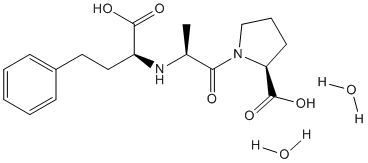All AbMole products are for research use only, cannot be used for human consumption.

Enalaprilat dihydrate is the first dicarboxylate-containing ACE inhibitor with an IC50 of 4 nM. It was developed partly to overcome these limitations of captopril. The sulfhydryl-moiety was replaced by a carboxylate-moiety, but additional modifications were required in its structure-based design to achieve a similar potency to captopril.

Biomedicines. 2023 May 30;11(6):1581.
Learning and Investigation of the Role of Angiotensin-Converting Enzyme in Radiotherapy for Nasopharyngeal Carcinoma
Enalaprilat Dihydrate purchased from AbMole
| Cell Experiment | |
|---|---|
| Cell lines | Rat cardiac fibroblasts cell lines |
| Preparation method | After 24 hours incubation in serum-free medium (DMEM), stimulating cells with IGF-I (1-100 nM) and coincubating with Enalaprilat (1 nM-10 μM) for 24 hours. Using a colorimetric immunoassay during the last 4 hours of the 24 hours incubation period to assesse cellular proliferation by 5-bromo-2'-deoxyuridine (BrdU) incorporation . Mearsuring the extinctions at 450 nm in an ELISA plate reader. All values consist of an n=9. |
| Concentrations | Dissolved in DMSO, final concentrations 1 nM - 10 μM |
| Incubation time | 24 hours |
| Animal Experiment | |
|---|---|
| Animal models | Male Sprague–Dawley rats |
| Formulation | Dissolved in a vehicle solution (1 mg in 950 μL of phosphate buffered saline and 50 μL 1M Na2CO3). |
| Dosages | 1 mg/kg |
| Administration | I.V. bolus |
| Molecular Weight | 348.4 |
| Formula | C18H24N2O5.2H2O |
| CAS Number | 84680-54-6 |
| Solubility (25°C) | DMSO 60 mg/mL |
| Storage |
Powder -20°C 3 years ; 4°C 2 years In solvent -80°C 6 months ; -20°C 1 month |
| Related ACE Products |
|---|
| Enalaprilat
Enalaprilat (MK-422 anhydrous), the active metabolite of the oral proagent Enalapril, is a potent, competitive and long-acting angiotensin-converting enzyme (ACE) inhibitor, with an IC50 of 1.94 nM. |
| Deserpidine
Deserpidine (Harmonyl) is an alkaloid isolated from the root of Rauwolfia canescens related to Reserpine. |
| H-Ile-Pro-Pro-OH hydrochloride
H-Ile-Pro-Pro-OH hydrochloride, a milk-derived peptide, inhibits angiotensin-converting enzyme (ACE) with an IC50 of 5 μM. |
| N-Benzoyl-Gly-His-Leu hydrate
N-Benzoyl-Gly-His-Leu hydrate is a leucine derivative, a polypeptide. |
| Bradykinin potentiator B
Bradykinin potentiator B (Bradykinin potentiating peptide B) is venom of Agkistrodon halys blomhoffi. |
All AbMole products are for research use only, cannot be used for human consumption or veterinary use. We do not provide products or services to individuals. Please comply with the intended use and do not use AbMole products for any other purpose.


Products are for research use only. Not for human use. We do not sell to patients.
© Copyright 2010-2024 AbMole BioScience. All Rights Reserved.
